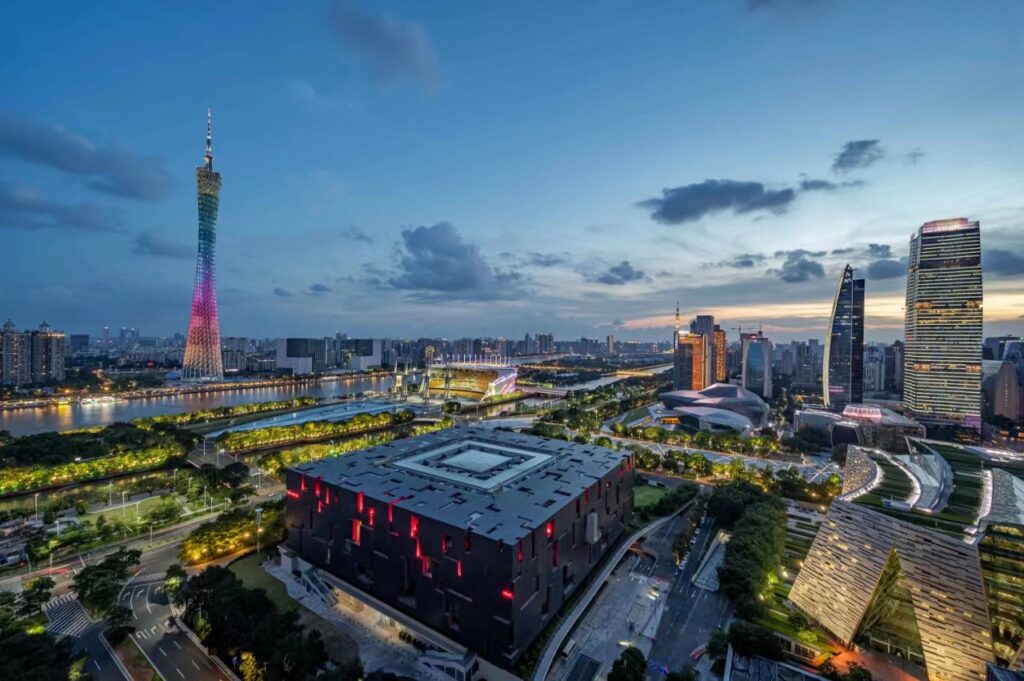Nestled at No. 2, Zhujiang East Road, Tianhe District, Guangzhou City, Guangdong Province, the Guangdong Museum stands as a cultural landmark in the Guangdong-Hong Kong-Macao Greater Bay Area and beyond, renowned for its rich history, vast collections, distinctive architectural design, and captivating exhibitions. Below is a detailed account of the museum’s several defining features:
1. Prolonged History and Profound Cultural Heritage
The planning of the Guangdong Museum dates back to 1957, with its original location situated on Wenming Road. Later, it was relocated to its current site and underwent meticulous construction, culminating in its grand opening in 2010. This museum has not only witnessed the cultural transformations and advancements of Guangdong and China since modern times but also carries the thousand-year-old historical memories and cultural legacies of the southern Guangdong region.

2. Unique Architectural Design
Inspired by the intricate beauty of Guangdong’s traditional ivory balls, the museum adopts a “treasure box” design concept, combining reinforced concrete core tubes with massive steel truss suspension structures. Its overall shape resembles an intricately carved treasure box, with internal spaces interconnected like the hollow layers of an ivory ball. The vast green lawns, a clear main entrance plaza, and a central boulevard create a harmonious and solemn ambiance.
3. Extensive Collections and Exhibitions
Boasting over 320,000 items (sets) in its collection, the Guangdong Museum encompasses various fields such as history, art, revolution, and nature. Its ancient calligraphy and painting, as well as ceramics, rank among the finest in China’s museums. It also holds prestigious collections of exported art, artifacts retrieved from underwater excavations, overseas Chinese artifacts, Chaozhou woodcarvings, and Duan inkstones. The museum’s exhibitions are divided into four major sections: History Gallery, Natural History Gallery, Art Gallery, and Temporary Exhibition Gallery, presenting a comprehensive and multi-faceted showcase of Guangdong’s historical and cultural evolution and natural resources.
4. Professional Academic Research and Cultural Heritage Conservation
The Guangdong Museum has achieved remarkable accomplishments in academic research and is the only provincial museum that manages and publishes two high-level academic journals simultaneously. It houses multiple research centers, including the “Image Anthropology Research Center,” “Marine Archaeological Relics Conservation Research Center,” and “Exported Art Research Center,” leading research in their respective fields. Moreover, the museum excels in cultural heritage conservation, establishing the country’s earliest specialized laboratory for marine archaeological relics conservation and undertaking conservation work for numerous national underwater archaeological excavations.
5. Digitization and Smart Museum Development
As one of the first pilot units for smart museum construction nationwide, the Guangdong Museum actively promotes digital transformation, creating a new museum form that integrates smart management, smart services, and smart protection. Through digital technology, the museum has achieved digital management of its collections, online exhibition displays, and interactive experiences for visitors, offering more convenient, efficient, and enriching cultural services.
6. Mobile Museums and Cultural Dissemination
The Guangdong Museum also actively promotes cultural services to rural areas, communities, and border regions, bringing exhibitions to a wider audience through mobile museums. With an annual average of over 200 exhibitions organized, benefiting over 4 million visitors, it has forged a new concept of an open, interconnected, and mutually beneficial museum.
In conclusion, the Guangdong Museum, with its prolonged history, unique architectural design, extensive collections and exhibitions, professional academic research and cultural heritage conservation, digitization and smart museum development, as well as mobile museums and cultural dissemination, stands as a significant window showcasing Guangdong’s historical culture and an important bastion for the inheritance of Lingnan culture.